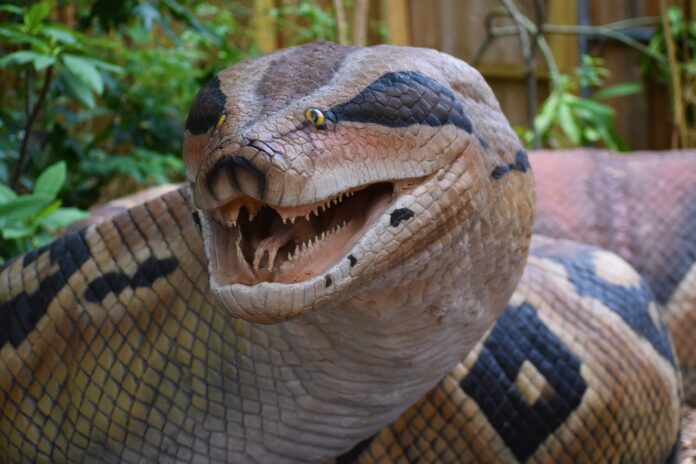The giant snake from South America is a “heroine” of numerous horror movies and adventure novels. The myths surrounding the anaconda are overwhelming. In reality, not all chilling tales should be believed. The formidable reptile can handle a wild boar, swallow a turtle, a young crocodile, a deer, or a capybara, but humans are a rather inconvenient prey. Attacks on people are rare, and there are reasons for this.
Anaconda Classification
The animal belongs to the squamate reptiles order. A non-venomous constrictor snake, it is classified under the subfamily “pythons.”
Known species of anacondas:
- Green Anaconda: Some individuals reach up to 5 meters in length. Their habitat is in the territory of South America, east of the Andes. They prefer swampy areas and large rivers.
- Paraguayan Anaconda: An adult snake is about 3 meters long. Found in Uruguay, Bolivia, Paraguay, and some regions of Argentina and Brazil.
- Eunectes de Schauensee: Inhabits the northwest of Brazil. Length is just over 2 meters.
- Eunectes beniensis: First described in 2002. This snake, reaching up to 4 meters, bears similarities to the Paraguayan anaconda.
Appearance, Anatomy, and Behavior
The largest recorded anaconda in the tropics weighed 97.5 kg and measured 5.2 meters long. There are many eyewitness accounts of 11-meter snakes, but none have provided proof. Their bodies are greenish-gray or yellow with dark spots arranged in a checkerboard pattern.
Anacondas are excellent swimmers, earning them the nickname “water boa.” They thrive in rivers, freshwater lakes, or humid environments and sometimes climb trees.
The snake hardly perceives sounds and has poor vision, but these deficiencies are offset by an extremely developed nervous system that senses water vibrations and thus helps them navigate.
Due to their powerful muscles, they can reach speeds of up to 40 km/h during hunting.
Their skeleton is flexible. The bones in the skull are connected by elastic ligaments, allowing the anaconda to open its mouth wide to swallow large prey. After a big meal, the diameter increases due to the mobility of the ribs.
The reptile prefers not too large prey: fish, rodents, lizards, birds, and small mammals. Digestion is slow, and a boar, caiman, or python can sustain it for several weeks. While an anaconda could attack a human, it would likely do so only if it mistakes them for its usual prey or is extremely hungry. Usually, the snake avoids humans. When threatened, it tries to bite. Its teeth are quite sharp and cause painful wounds, but the saliva is harmless.
How the Anaconda Kills
The snake is a lazy creature. Concealed in the water, it patiently waits for another animal to come close. Once it senses food, it strikes and grips the prey with its fangs, preventing escape. It then coils around the body and either constricts the prey or dives underwater to drown it.
Escaping from the snake’s deadly grip is quite challenging. The compression force reaches 16 kg per square centimeter. The anaconda consumes its prey whole, starting with the head, as this reduces resistance from the limbs.
Adult anacondas can easily swallow prey weighing 14-50% of their own body mass.
Can Anaconda Eat a Human?
The water boa does not initiate aggression and avoids encounters with people. There are many videos online showing the “Amazonian monster” being touched without reacting.
The anaconda is the heaviest known snake but is shorter than the reticulated python, which reaches 7 meters. Its average length is no more than 4.5 meters, which is clearly insufficient to swallow an adult human. The meat of Homo sapiens can cause stomach upset, requiring the snake to regurgitate it.
There is also the issue of size: the widest part of the body is the shoulders. No matter how hard the reptile tries, a man with a well-developed torso won’t fit inside. People with a slender build or children might become “desserts” for the tropical serpent. There is a documented case where a 13-year-old Indian boy bathing in a river was captured by a reptile, the only confirmed case of an anaconda attacking a human so far. It is likely that the snake mistook the boy for a capybara or another animal.
Famous zoologist Paul Rosolie, who runs a Discovery channel, conducted an experiment where he wore a strong vest and covered himself in pig’s blood to entice the giant anaconda. For a long time, the massive monster did not bite, apathetically observing Paul, but eventually became agitated and ate him. Sensors monitored the condition of both the scientist and the reptile. It is unknown how the naturalist managed to escape, but both participants in the experiment survived.
The anaconda is a legendary inhabitant of the South American tropics. Rumors of its bloodthirstiness and greed are exaggerated; the amphibian does not feed on humans but may attack if threatened or extremely hungry. The “queen of snakes” is unlikely to swallow you but could strangle or injure you.
